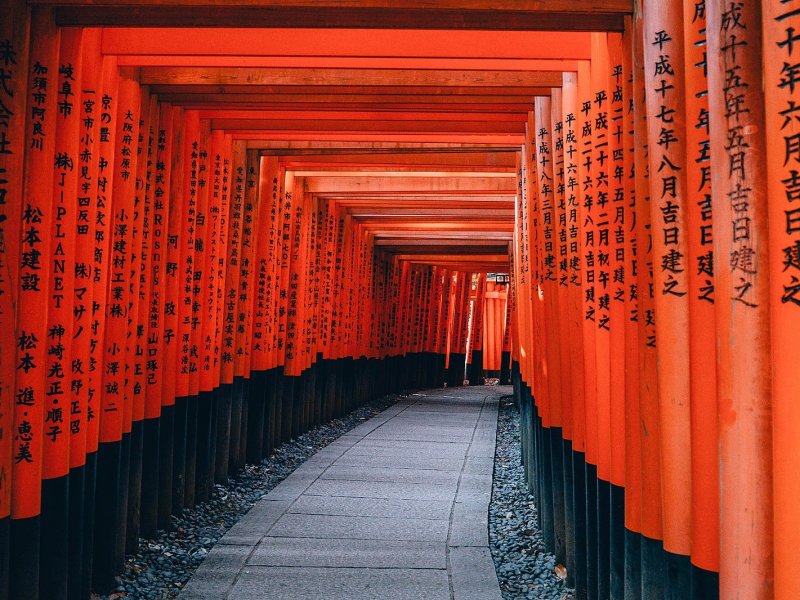https://www.dekitabi.com/itinerary/inari-honmachi-walking-tour
Kyoto, a city renowned for its timeless beauty and rich history, offers travelers an opportunity to immerse themselves in Japan’s cultural and spiritual heritage. Among the myriad of temples and shrines, five stand out for their unique charm and historical significance: Fushimi Inari Taisha, Tofuku-ji Temple, Shorinji Temple, Rengeo-in Temple (Sanjūsangen-dō), and Head Temple Chishakuin. Each site provides a distinct experience, from the enchanting torii gates of Fushimi Inari to the serene gardens of Tofuku-ji. Let’s delve into the wonders these sacred places have to offer.
Fushimi Inari Taisha

https://www.dekitabi.com/attraction/fushimi-inari-taisha
Fushimi Inari Taisha, one of Japan’s most iconic shrines, is located in southern Kyoto. This Shinto shrine is dedicated to Inari, the god of rice and prosperity, and is famous for its thousands of vibrant red torii gates, which create a mesmerizing pathway up Mount Inari. Visitors often find themselves captivated by the seemingly endless corridor of gates, which wind through serene wooded trails and offer breathtaking views of Kyoto.
The main hall, known as the Honden, stands majestically at the base of the mountain. Built in the 14th century, it features traditional Japanese architecture with intricate wooden carvings and a striking vermilion color. The shrine complex also includes several smaller shrines, each with its own unique character and history.
One of the most popular activities at Fushimi Inari is the hike to the summit of Mount Inari. The trail is dotted with smaller shrines, statues of foxes (Inari’s messengers), and charming tea houses where travelers can rest and enjoy local delicacies. The hike takes about 2-3 hours round trip, depending on how often you stop to take in the sights and sounds.
Tofuku-ji Temple

https://www.dekitabi.com/attraction/tofuku-ji
Tofuku-ji Temple, a Zen Buddhist temple, is located in southeastern Kyoto and is renowned for its stunning autumn foliage. Founded in 1236 by the powerful Fujiwara clan, Tofuku-ji is one of the Five Great Zen Temples of Kyoto. The temple complex is extensive, featuring beautiful gardens, historic buildings, and picturesque bridges.
The most famous garden at Tofuku-ji is the Tsutenkyo Bridge, which spans a ravine filled with maple trees. In autumn, the leaves turn vibrant shades of red and orange, creating a breathtaking scene that attracts visitors from all over the world. The view from the bridge is especially stunning, offering a panoramic vista of the temple grounds.
Another highlight of Tofuku-ji is the Hojo, the abbot’s quarters, which are surrounded by four distinct gardens designed by renowned landscape architect Mirei Shigemori. Each garden represents a different element, such as the Eastern Garden’s use of moss and stones to symbolize the mythical islands of the immortals. The Western Garden, with its checkerboard pattern of moss and white gravel, is a modern take on traditional Zen aesthetics.
Shorinji Temple

https://www.dekitabi.com/attraction/shorinji-kyoto
Shorinji Temple, also known as Shorin-ji, is a lesser-known gem located in northern Kyoto. This Rinzai Zen Buddhist temple is part of the Myoshin-ji school and offers a tranquil escape from the busier tourist spots. Established in the late 13th century, Shorinji has a rich history and a serene atmosphere.
The temple grounds are peaceful and inviting, with well-maintained gardens and traditional wooden buildings. One of the main attractions is the Karesansui (dry landscape) garden, which features meticulously raked gravel and carefully placed rocks, creating a sense of harmony and tranquility. Visitors can sit in contemplation and enjoy the simplicity and beauty of the Zen garden.
Shorinji Temple also offers zazen (seated meditation) sessions for those interested in experiencing Zen practice firsthand. These sessions provide an opportunity to learn about Zen Buddhism and practice mindfulness in a serene setting.
Rengeo-in Temple (Sanjūsangen-dō)

https://www.dekitabi.com/attraction/rengeoin-sanjusangendo
Rengeo-in Temple, commonly known as Sanjūsangen-dō, is a unique and awe-inspiring site located in eastern Kyoto. The temple’s name translates to “Hall with Thirty-Three Spaces,” referring to the architectural design of the main hall, which features 33 bays between the columns. This long hall houses 1,001 statues of Kannon, the Buddhist goddess of mercy.
The main statue, a seated Thousand-armed Kannon, is flanked by 1,000 life-sized standing Kannon statues, each with subtle differences. This impressive display creates a powerful and serene atmosphere, with the statues arranged in neat rows that stretch the length of the hall. The sheer number and beauty of the statues leave a lasting impression on visitors.
Sanjūsangen-dō is also known for its annual archery contest, called Tōshiya, which has been held since the Edo period. Archers from all over Japan gather to compete in this traditional event, showcasing their skills and paying homage to the temple’s spiritual significance.
Head Temple Chishakuin

https://www.dekitabi.com/attraction/chishakuin
Head Temple Chishakuin, or Chishaku-in, is a historic and culturally significant temple located near Kyoto Station. This Shingon Buddhist temple is the head temple of the Chisan sect and boasts beautiful gardens, historic paintings, and impressive architecture.
The temple’s main hall, the Hondō, houses important cultural treasures, including fusuma (sliding door) paintings by the renowned artist Hasegawa Tōhaku. These paintings, depicting natural landscapes and seasonal flowers, are considered masterpieces of Japanese art and add to the temple’s serene ambiance.
Chishakuin’s gardens are another highlight, particularly the Chisen-kaiyu-shiki garden, which features a central pond surrounded by lush greenery and carefully arranged stones. The garden is designed for strolling and offers a peaceful retreat from the hustle and bustle of the city. The temple grounds also include a museum that displays various artifacts and artworks related to the temple’s history and the Shingon sect.
Conclusion
Kyoto’s Fushimi Inari Taisha, Tofuku-ji Temple, Shorinji Temple, Rengeo-in Temple, and Head Temple Chishakuin each offer unique insights into Japan’s cultural and spiritual heritage. From the iconic torii gates of Fushimi Inari to the tranquil gardens of Tofuku-ji, these sites provide a diverse range of experiences for travelers seeking to explore Kyoto’s rich history. Whether you’re admiring the thousands of Kannon statues at Sanjūsangen-dō or practicing zazen at Shorinji, each visit promises to be a memorable and enriching journey through Japan’s ancient traditions.


Leave a Reply